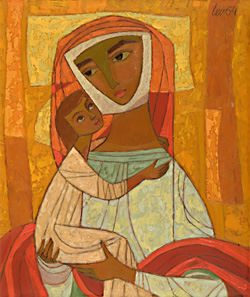Art returns to Ukraine
A collection of works by noted 20th-century expatriate Ukrainian artists has been donated to Ukraine
On February 12 the Ukrainian Canadian Halyna Horun-Levytsky presented this icon to Ukraine at the Consulate General in Toronto. Precious and interesting canvases by Vasyl and Mykola Krychevsky, Oleksa Hryshchenko, Yakiv Hnizdovsky, Liuboslav Hutsaliuk, Mykhailo Kmit, Vasyl Khmeliuk, Halyna Mazepa, and Mykola Nedilko have been added to the stock of the Sheptytsky National Museum in Lviv. This unique collection features the creative legacy of twenty noted Ukrainian artists and numbers 119 works. It represents varying, at times antagonistic creative styles, trends, and techniques. These thematically displayed canvases (landscapes, still lifes, and portraits) vividly and colorfully reflect the artists’ creative life and shed light on the cultural world of the Ukrainian diaspora that has come closer to Mother-Ukraine after it regained independence toward the end of the 20th century. This is the world that remains only partially explored and absorbed by Ukrainian culture.
Among the oldest pictures are Alushta, the Crimea (1924) by the outstanding Ukrainian artist Vasyl Krychevsky. Among the rarities is Yakiv Hnizdovsky’s oil Flower (1974). The collection also boasts one of Vasyl Khmeliuk’s best pictures, A Woman in White (1944), favored by leading critics. There are many other unique works of Ukrainian art coming from and depicting vast geographical areas: Europe, North and South America, and Australia. These artists lived, worked, and won professional recognition far beyond the borders of Ukraine. All of them lived pilgrim lives and were glorified by the world outside their native land. Yet their creations rest on the unified Ukrainian cultural foundation. All were outstanding Ukrainians who remained unknown in Ukra ine for a long time. Halyna Horun-Levytsky has spent decades putting together her collection and the main selection criteria remained the same: Ukraine must have the best.
The noted Canadian art critic Daria Darewych said that the canvases by Halyna’s husband Myron Levytsky were in the focus and heart of the collection. The works included in the collection offer an opportunity to trace, even if fleetingly, the creative path of the eminent artist, including the Ukrainian period. The earliest picture included in the collection was created in 1938 in Lviv.
Halyna Horun-Levytsky started her collection in the late 1960s, working purposefully and meticulously. This allowed her to put together a number of precious oeuvres that marked special accomplishments in the creative biography of this gifted and versatile artist. The collection boasts 79 canvases, including the well-known Oxen at Sunset done in Toronto (1960). This picture followed a composition that had won the artist his name and award at the Gallery Ror Volmar Paris (1958). And, of course, his well-known Mother of God (1964), praised by critics as one the masterpieces of Levytsky and contemporary Ukrainian icon-painting.
It was thus, step by step, over decades, that her singular collection took shape. “Halyna Levytsky purchased the best works by Ukrainian artists and only those she liked. She consciously reduced her selection to Ukrainian painters who worked outside Ukraine, who were banned, ignored, or unwelcome in their home country. The importance of preserving their creations was the conscious motive of her collection. Even at that time she planned and dreamed of handing it over to Ukraine, thus returning the lost works of art to the mainland. She wanted Ukraine to have the works of these artists and know their names,” writes the publisher Lidia Lykhach in the foreword to the album “Collection by Halyna Horun-Levytsky” (Rodovid Publishers, 2006).
This attractively and tastefully designed publication was the first step made by the collection on its long road to Ukraine. It was the source of information for the State Service for Monitoring Passage of Cultural Valuables across the State Border of Ukraine, tasked with the acquisition of cultural values for the Ukrainian state.
It was my official duty to secure the collection’s transfer to Ukraine and I was fortunate enough to be the first to meet with its owner last November. It happened at Horun-Levytsky’s place in Toronto and it was an unforgettable meeting. I saw an energetic, quick-witted, frank, and straightforward lady capable of cutting calves with her tongue, to use her own expression. Her eyes, gestures, and language were proof of inborn culture, intellect, and artistic talents that were expressed in several portraits. I will always remember our deep-reaching philosophical discussion, her sage remarks born of lifelong experience, her independent observations embellished by eloquence, and her genuinely keen interest in sociopolitical life across the world and in Ukraine. I will also carry memories of her true, deeply rooted and unwavering patriotism, and love for her native Volhynia (Volyn) and the rest of Ukraine. Such sentiments can only be instilled amidst the fragrant leaves of grass of one’s childhood years, nourished by the crystal clear sources of folk culture, and warmed by the loving parents’ hands.
She was 18 when she had to leave Ukraine forever during the Second World War, but she would never disown, forget, or betray her country.
Halyna Horun-Levytsky has shown the invincible will of her spirit and, most importantly for us, an example of indefatigable work in the name of and for the glory of Ukraine, as evidenced by her generous gift.
Now the collection is on its way to Ukraine.
In conclusion, I am pleased to note that she will stay for several days in Kyiv on her way to Lviv. The Ukrainian Home has kindly agreed to display her collection for a brief period in February.
Yurii Savchuk holds a Candidate of Historical Sciences degree and is head of the State Service for Monitoring Passage of Cultural Valuables across the State Border of Ukraine.






